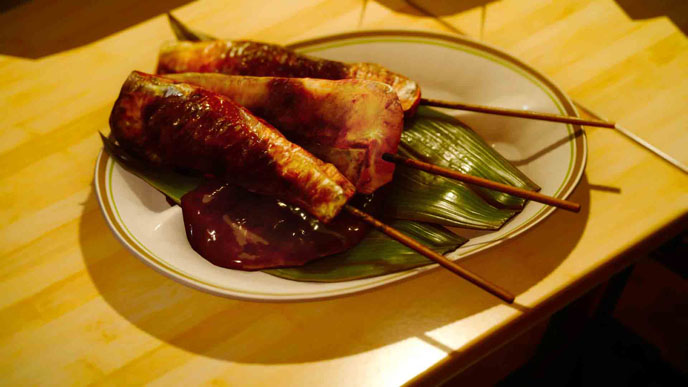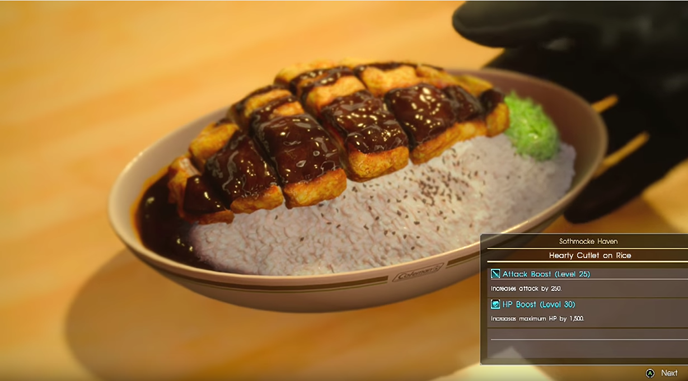
A lot of words have been dedicated to the food of Final Fantasy XV and as the author of a videogame cookbook, I understand the appeal. Sometimes videogame food doesn’t even have to look very realistic to be appealing. In this particular case, the visual experience was very deliberately cultivated to be an appetizing one as well. As game director Hajime Tabata told Eater, “In Japan, we have a term called ‘meshi-tero’ (an abbreviation of the Japanese-English combo phrase ‘Meshi (food) Terror’ and similar to the English term ‘food porn’), but that pretty much summed it up. We have to create truly delicious-looking food scenes similar to those that appear in movies and anime.” And if you’ve seen any of the screenshots of food from Final Fantasy XV, then you’re aware they’ve succeeded.
In Final Fantasy XV, recipes can either be cooked around a campfire or purchased from a restaurant. From this article we chose one of each. Stay tuned for future installments, which will include Sweet Saltwater Crustacean Curry and Croque Madame.
Nebula Salmon Teriyaki
It wasn’t until I traveled away from the greater Seattle area that I realized teriyaki isn’t a “thing” in other places. In fact, it wasn’t even that popular in Japan until a revival of the dish in Seattle during the 1970s brought it back to its home country’s attention. The basic recipe for the sauce calls for a simple mixture of soy sauce, brown sugar, and mirin, but today there are many variations, some boasting up to hundreds of ingredients, dominating the market today.
The recipe in Final Fantasy XV calls for nutmeg, which is a fine spice to compliment the salty sweetness of teriyaki sauce, but of course, most folks do not have a whole nutmeg lying around the house. They’re also very difficult to break into pieces, and I do not suggest using more than ? of a nutmeg for this recipe. Alternately, you can use a small stick of cinnamon, which I prefer. I also like to add a star anise, but never the whole flower, just ¼-½ of it, broken into pieces. The idea is to add enough spice to keep things interesting but not so much that the sauce tastes like a Snickerdoodle.
A challenge in making salmon is that once cooked, it flakes easily and will not tolerate agitation or frequent stirring. Thus it is not ideal for most sauce based dishes. My suggestion is to broil the salmon first, using a high heat to flavor the meat, then drizzling it with teriyaki sauce and garnishing with sliced green onion and sesame seeds. For that you’ll need a cheap plastic squirt bottle, so as the kind you use for ketchup or mustard. For salmon teriyaki specifically, I recommend it but if you don’t plan on eating this dish a lot, spoon the sauce over the finished salmon instead. Remember to let the sauce fully cool if you’re going to use a plastic bottle so as to avoid food poisoning. If using fresh ginger and garlic (which clog up the nozzle) you may wish to strain the sauce before the thickening process as well.
As for the type of salmon, avoid Atlantic or farmed. The Nebula salmon in the game seems to most strongly resemble the chum salmon, which have the largest span of any Pacific salmon and can be found both in Japan and the United States. It’s personally what I buy from Amazon Fresh weekly, for about $5 per 8 oz frozen fillet. I suggest using tailpieces for this recipe if you can.
2 cups (480 ml) soy sauce
1 cup (240 ml) mirin
1 tablespoon (15 ml) of sake
1 cup (120 g) light brown sugar
1 tsp (5 ml) minced garlic
1 tsp minced ginger
2 tablespoons (30 ml) cornstarch for thickening
2 tablespoons cold water or stock
Sesame seed oil
One half of a cinnamon stick or one third a piece of nutmeg (do not use powdered nutmeg)
Star anise, if desired, broken into pieces (use two “petals”)
One salmon fillet or tail piece per person, about 8-12 oz per piece
Green onions
Toasted sesame seeds
Place a small saucepan on medium low heat with just enough sesame oil to coat the bottom. Once it has fully heated, add the cinnamon and star anise and heat until the cinnamon is fully unfurled (if using nutmeg, allow it to toast on at least two “sides” before moving to next step). Combine soy sauce, mirin, sake, and brown sugar in the saucepan and bring to a boil. Whisk until sugar is dissolved. Reduce heat and simmer, then combine two tablespoons of cornstarch with two tablespoons cold water or stock in a small glass or bowl, and whisk with a fork. Add to sauce, stirring rapidly, until it thickens. Repeat if desired.
Meanwhile, preheat the oven’s broiler on HIGH and place the salmon pieces, skin-side down, on a baking sheet covered in foil. Brush them lightly with olive oil (if desired) then place in the oven to cook for at least nine to ten minutes. The rack should be about six inches away from the top. Check frequently, and allow to broil until the edges are just browned and slightly crispy (mine took about 14 minutes), then remove from the heat.
Drizzle with teriyaki sauce and garnish with sliced green onions and toasted sesame seeds. Serve with steamed white rice.
Note: if you wish to grill these skewer-style like in the game, I suggest you purchase a skinless salmon fillet, and cut it into cube-like strips while it’s still in a semi-frozen state, so the flesh doesn’t turn to mush. Use thin, light bamboo skewers. If using a grill, keep the temperature about 350 and turn frequently, cooking about three minutes on each side. If you’re actually cooking it around a campfire? Um…please be careful.
Hearty Cutlet on Rice
The “Hearty Cutlet on Rice” in Final Fantasy XV might be better known as tonkatsu, a deep-fried breaded pork cutlet, also commonly made with chicken. The origins of katsu are Japanese but I still consider this dish akin to America’s fried chicken and BBQ sauce. I prefer chicken, as pork can be difficult to chew through. It ruins the breading. The Final Fantasy XV recipe also calls for fowl specifically, so there you go.
You can fry some chicken cutlets whole, or if you prefer, slice the chicken before frying and coat each slice individually. I like to coat them in Ziploc bags to reduce the mess. When you get to the panko breading stage, don’t be afraid to pound the hell out of the chicken to make sure the coating sticks; good katsu relies on thick fried breading and the experience is greatly diminished if panko is soggy, spotty, or comes off in flakes.
I prefer to use a cast iron skillet for frying, as it provides the most even heat distribution while allowing enough depth to fully coat the meat. If you do not have a cast iron skillet, a deep frying pan or wok can be used. Wear long sleeves and use a grease guard if you have one. Long bamboo cooking chopsticks are also helpful.
2 lbs. (about 1 kg) boneless chicken, either chicken cutlets or sliced strips of chicken tenderloin or breast
1 cup (120 g) Shirakiku honey panko breading
2 eggs, slightly beaten
1/4 cup (30 g) flour
Salt and pepper to taste
Vegetable oil
1 1/2 cup (350 ml) ketchup
1/4 cup (60 ml) Worcestershire sauce
3 tablespoons (45 ml) sake
3 tablespoons (45 ml) soy sauce
1 tablespoon (15 ml) yellow mustard
1 tsp (5 ml) garlic powder
Pepper to taste
Start by adding enough vegetable oil to your wok or pan to almost completely submerge the chicken (will vary from pan to pan). Heat on medium until the oil is moving, but not boiling, about 350 degrees F (180 C).
Place the flour, salt, and pepper in one bag, the eggs in another, and the panko breading in the last. Make sure any excess moisture is removed from the chicken, then put in the bag of flour and shake. Repeat with egg, and then panko. As noted above, beat the hell out of the chicken while it’s in the panko, coating as much as possible.
Place the chicken in the skillet, slipping in gently to avoid splatter. Fry until the edges become light golden brown and the meat is slightly firm when you push it. Then the flip cutlet with long chopsticks or tongs. Continue frying, turning every 20 to 30 seconds. Coating should be browned but not burned. You will be able to tell the cutlet is fully cooked once the meat is firm and slightly turned up at the edges. If the coating or the oil begins to smoke, lower the heat for the next batch.
Place on paper towels to drain. Once the cutlets are cooled slightly, use a sharp butcher knife to slice into long strips. Serve with steamed Jasmine rice and fresh katsu sauce.
To make your own katsu sauce, combine ketchup, Worcestershire sauce, mustard, sake, soy sauce, and garlic powder in small bowl and whisk until well blended. Sprinkle with pepper to taste and refrigerate until needed.
Note: you can also use this for the Breaded Cutlet With Tomato recipe, just substitute a plain tomato sauce and, if you prefer, bake the cutlet instead of frying.
Got an idea for our upcoming recipes? Hit us up at @PasteGames on Twitter.
Holly Green is the assistant editor of Paste Games and a reporter and semiprofessional photographer. She is also the author of Fry Scores: An Unofficial Guide To Video Game Grub. You can find her work at Gamasutra, Polygon, Unwinnable, and other videogame news publications.

